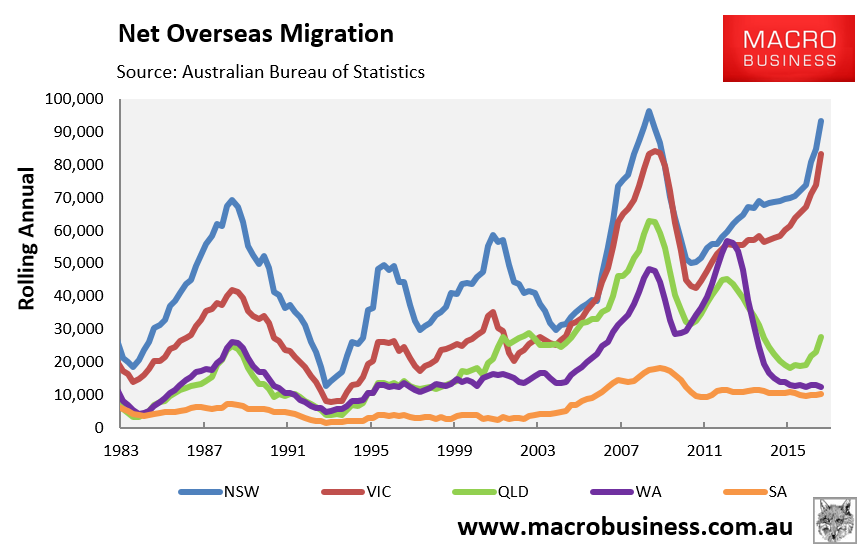This site has noted repeatedly that one of the key reasons why Australia’s high population growth (immigration) is lowering the living standards of existing residents is because of the strain that it places on infrastructure, which inevitably leads to more congestion on roads, public transport, as well as more expensive housing.
Basic math (and commonsense) suggests that if you double the nation’s population, you need to at least double the stock of infrastructure to ensure that living standards are not eroded (other things equal).
In practice, however, the solution is not that simple. In already built-up cities like Sydney and Melbourne, which are the key magnets for new migrants (see next chart), the cost of retrofitting new infrastructure to accommodate greater population densities can become prohibitively expensive because of the need for land buy-backs, tunnelling, as well as disruptions to existing infrastructure.

In fact, the cost of such projects is so great that the Grattan Institute estimated that “unprecedented infrastructure spending by states and territories” since the escalation of population growth from 2004 is “largely responsible for a $106 billion decline in their finances since 2006“, and that “after a threefold increase in capital spending over the last 10 years, states are paying 3 per cent more of their revenues in interest and depreciation”.
The latest example of these ‘dis-economies of scale’ in infrastructure investment comes from Melbourne, where Opposition Liberal leader, Matthew Guy, has committed to spending billions removing more than 50 of the worst traffic intersections in Melbourne and Geelong with underpasses to replace traffic lights and roundabouts. From The Canberra Times:
Opposition Leader Matthew Guy has pledged “the biggest traffic congestion-busting project in Victoria’s history” and will spend billions of dollars grade-separating major intersections around Melbourne and Geelong…
“Census data shows that 74 per cent of Melburnians take a car to work every day,” Mr Guy said. “That’s why more of the same band-aid approach to addressing traffic congestion won’t work.”
Thirty-five intersections would be removed in the first four years of the project, between 2018 and 2022, with a further 20 to follow, the Opposition has promised.
The project would cost between $4.1 billion and $5.3 billion, it estimates…
Underpasses will be the preferred engineering solution, though the Coalition did not rule out building overpasses, despite its firm opposition to building rail bridges in level crossing removals…
Funding would come from a roughly equal three-way split between the state and federal governments and the proceeds of the sale of Snowy Mountain Hydro Scheme.
Last year, a 50-year lease over the Port of Melbourne was sold by the Victorian Government for around $10 billion, with the proceeds used to fund the removal of level crossings around Melbourne. And now, Victoria will use the proceeds from the Snowy Mountain Hydro Scheme to pay for a part of this project.
While I don’t have an issue with removing level crossings or intersections, provided it stacks-up on cost-benefit grounds, these projects do raise broader issues about the structure of the Victorian economy. As shown yesterday, Victoria’s growth model is predicated on continuous strong population growth: essentially importing large numbers of people each year and then building housing and infrastructure to accommodate them. Now the State is looking to sell one of its last major infrastructure assets in a bid to raise funds necessary to overcome infrastructure bottlenecks caused, to a large extent, by its own population growth fetish (chicken meet egg).
It’s a short-sighted approach that risks undermining the living standards of the incumbent population, which must continually put up with greater congestion, reduced amenity, and overall lower living standards. Such an economic model also only works for as long as the strong immigration and construction continues. As soon as they slow, so does the economy.
High immigration and population growth would be okay if it was for a purpose and fitted an overall plan. However, in Australia’s case it is uncoordinated ponzi-nomics. The sale of the Port of Melbourne and now the Snowy Mountain Hydro Scheme to band-aid over infrastructure constraints is merely the latest manifestation.

